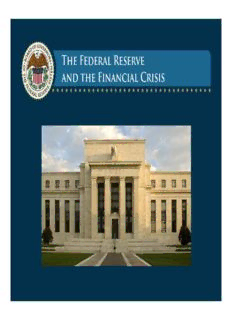
Fed Aftermath of Crisis PDF
Preview Fed Aftermath of Crisis
Lecture 4: The Aftermath of the Crisis 2 The Fed’s Efforts to Restore Financial Stability • A financial panic in fall 2008 threatened the stability of the global financial system. • In its lender‐of‐last‐resort role, the Federal Reserve provided liquidity (short‐term collateralized loans) to help stabilize key financial institutions and markets. 3 The Fed’s Efforts to Restore Financial Stability • The Fed worked closely with the Treasury, other regulatory agencies (such as the FDIC and SEC). • Coordination with foreign central banks included the creation of foreign currency swaps. – The Fed provided dollars to other central banks in exchange for foreign currencies. – The swaps enabled foreign central banks to meet the dollar funding needs of their own financial institutions. 4 The Fed’s Continuing Efforts to Strengthen the Banking System • The Fed led stress tests of the 19 largest U.S. banks in the spring of 2009, which helped restore investor confidence and allowed banks to raise about $140 billion in private capital. • Recent stress tests conducted by the Fed showed substantial further improvements in bank capital and banks’ resilience to shocks. 5 Evaluation of the Special Lender‐of‐Last‐Resort Programs • Results: The programs – arrested runs on various types of financial institutions – restored financial market functioning, restarted flow of credit, and supported resumption of economic growth • Programs were largely phased out by March 2010. 6 Evaluation of the Special Lender‐of‐Last‐Resort Programs • Financial risks to the Federal Reserve were minimal: – Lending was mostly short‐term and backed by collateral; thousands of loans were made, none defaulted. – Although the objective of these programs was stabilization, not profit, taxpayers came out ahead. 7 Monetary Policy during the Crisis • The Fed used lender‐of‐last‐resort policy to help stabilize the financial system. To stabilize the economy and promote economic recovery, the Fed turned to monetary policy. 8 Monetary Policy during the Crisis • Conventional monetary policy involves management of a target short‐term interest rate (the federal funds rate). Because longer‐term rates tend to fall when the Fed lowers the short‐ term rate, and because lower longer‐term rates tend to encourage purchases of long‐lasting consumer goods, houses, and capital goods, cutting the federal funds rate helps stimulate the economy. 9 Monetary Policy during the Crisis • Monetary policy is conducted by the Federal Open Market Committee (FOMC). • The FOMC meets in Washington, D.C. eight times a year. During the crisis, it sometimes also held unscheduled videoconferences. 10
Description: